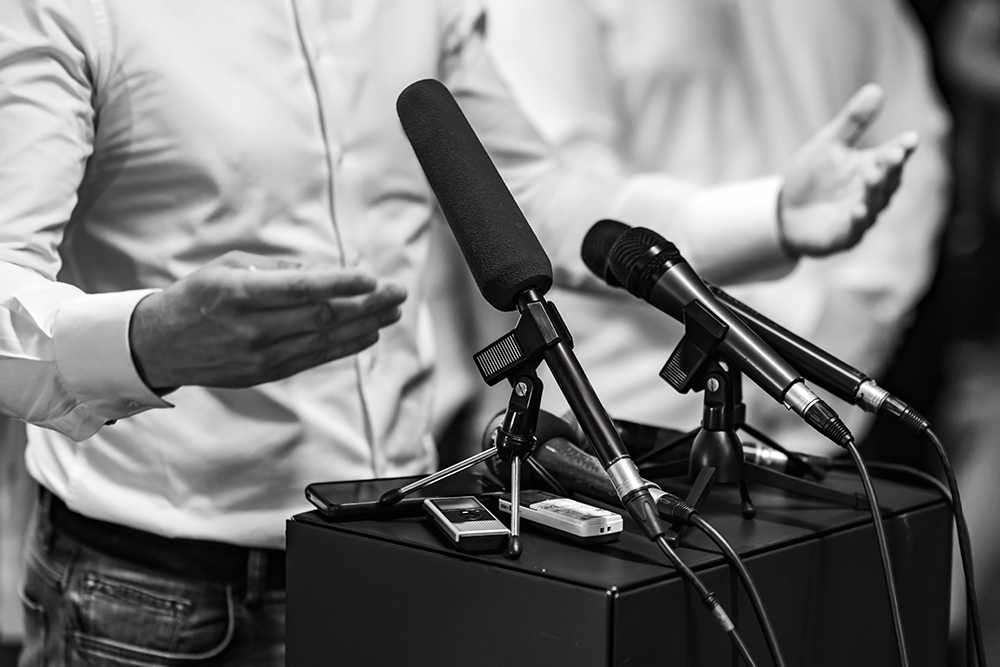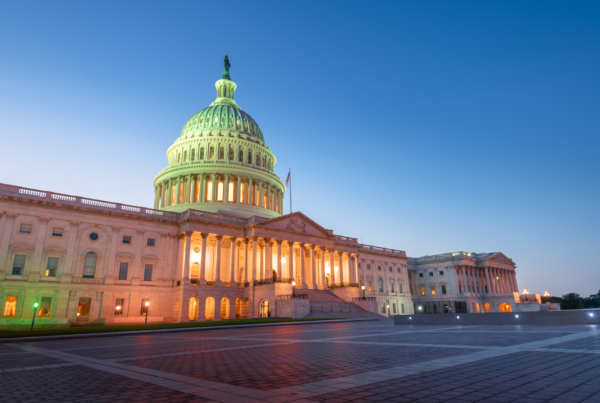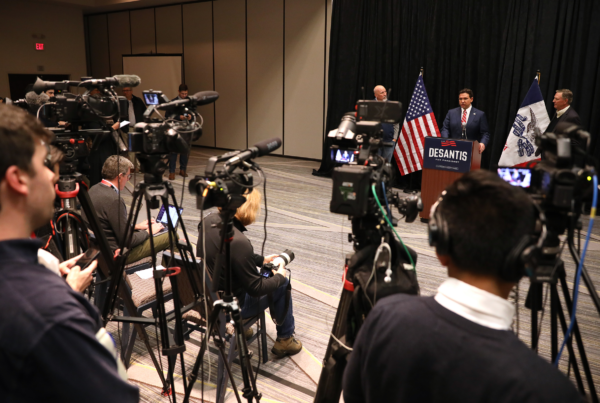Outside Groups Largely Absent
(MIDDLETOWN, CT) November 20, 2019 – A new analysis from the Wesleyan Media Project shows that $20.5 million has been spent on television advertising by candidates in the presidential race since October 20 (Table 1). Making their first ad buys this past month were Elizabeth Warren, Andrew Yang, and Steve Bullock. Warren started advertising on national cable on October 26 and in Iowa on November 4, while both Bullock and Yang started advertising in Iowa in the first week of November. Bernie Sanders and Pete Buttigieg have also ramped up television spending in the past month, with Sanders spending $1.8 million and Buttigieg spending $1.5 million.
“Buttigieg has surged in the polls in Iowa and New Hampshire recently at the same time that his campaign has ramped up ad spending—both TV and digital,” said Travis Ridout, co-director of the Wesleyan Media Project. “While it’s not possible to attribute the surge entirely to his ad spending, it has certainly played some role in his recent success. A strong debate performance tonight, combined with continued heavy ad spending, could help cement his place in the top tier of Democratic candidates.”
Steyer continues to outpace the other candidates in television spending, accounting for over 60 percent of the past month’s spending total ($13 million).
“Residents of early voting states are seeing many more television ads from presidential candidates this cycle than they did in the 2016 presidential race, and the reason can be summed up in one word: Steyer,” said Erika Franklin Fowler, co-director of the Wesleyan Media Project.
Table 1: TV Ad Spending by Candidate (Since October 20 and Full Year)
| Airings (since Jan 4) | $ Spent (since Jan 4 ) | Airings (since Oct 20) | $ Spent (since Oct 20) |
|
|---|---|---|---|---|
| Steyer | 80,504 | 36,411,014 | 21,013 | 13,193,954 |
| Sanders | 6,021 | 2,683,523 | 4,400 | 1,822,779 |
| Buttigieg | 4,016 | 2,710,585 | 2,056 | 1,546,300 |
| Trump | 4,630 | 5,649,399 | 2,090 | 1,412,884 |
| Yang | 931 | 1,067,892 | 931 | 1,067,892 |
| Klobuchar | 1,313 | 848,400 | 805 | 426,148 |
| Biden | 1,583 | 962,430 | 700 | 363,855 |
| Warren | 545 | 295,350 | 545 | 295,350 |
| Bennet | 1,565 | 843,185 | 351 | 228,242 |
| Bullock | 344 | 147,587 | 344 | 147,587 |
| Sestak | 103 | 56,200 | 44 | 31,352 |
| Castro | 50 | 23,500 | 27 | 17,350 |
| Delaney | 1,431 | 518,430 | 0 | 15,000 |
| Gillibrand | 2,788 | 1,099,870 | 0 | 0 |
| Gabbard | 1,302 | 488,270 | 0 | 0 |
| Harris | 810 | 389,345 | 0 | 0 |
| Gravel | 5 | 7,700 | 0 | 0 |
| TOTAL | 107,941 | 54,202,680 | 33,306 | 20,568,693 |
| Numbers include ads aired on national network, national cable and broadcast television between January 5 and November 16, 2019, and between October 21 and November 16, 2019. Spending totals for candidates may differ from our prior report due to changes in Kantar/CMAG estimates of total spending. CITE SOURCE OF DATA AS: Kantar/CMAG with analysis by the Wesleyan Media Project. |
||||
TV Ad Spending Comparable to 2015-16;
Ad Volume Way Up
Table 2 shows that spending on TV advertising is on par with the previous presidential race ($56 million in the current cycle v. $59 million in the previous). But the volume of ad airings is up considerably from the previous cycle (109,000 versus 46,000 in the previous). This suggests that ad sponsors are, on average, paying less for their ads than in the past. One reason for the cheaper ads is a change in their sponsorship.
Table 2: TV Ad Spending and Airings by Cycle
| Cycle | Total Spending ($) | % Group Spending | Total Airings | % Group Airings |
|---|---|---|---|---|
| 2015-2016 | 59,471,780 | 80.5% | 46,415 | 63.8% |
| 2019-2020 | 56,435,843 | 4.0% | 109,490 | 1.4% |
| Numbers include ads aired on national network, national cable and broadcast television through November 16. Spending totals for candidates may differ from our prior report due to changes in Kantar/CMAG estimates of total spending. CITE SOURCE OF DATA AS: Kantar/CMAG with analysis by the Wesleyan Media Project. |
||||
In contrast to the race for the 2016 presidential nomination, outside groups (which are not entitled to television stations’ lowest unit rate like candidates are) have largely stayed out of the race for the 2020 nomination. At this stage of the presidential nomination race in 2016, outside group money dominated; 80.5 percent of election-related TV ad spending (and 63.8 percent of airings) were from groups. Groups such as Right to Rise, a super PAC that supported Jeb Bush, were spending multi-millions. But in the current race, groups are largely absent, as only 4 percent of TV ad spending and 1.4 percent of airings were from groups.
Table 3 shows the top groups that have aired ads in the presidential race in the past month. American Bridge 21st Century Foundation and American Bridge 21st Century PAC have aired ads featuring everyday citizens who voted for Trump in 2016 but have since regretted their decisions. These ads aired in Wisconsin and Michigan.
“Where are the groups this year,” asked Michael Franz, co-director of the Wesleyan Media Project. “It seems candidates have done so well at raising money from small-dollar donors that they haven’t needed to turn to those who can invest millions. Moreover, many large-dollar donors may still be waiting out this race to see which horse to bet on.”
Table 3: TV Spending by Group Ad Sponsors
| Spending ($) | Lean | |
|---|---|---|
| American Bridge 21st Century Foundation | 77,116 | anti-Trump |
| American Bridge 21st Century PAC | 132,628 | anti-Trump |
| Defend American Democracy | 104,500 | anti-Trump |
| Numbers include ads aired on national network, national cable and broadcast television from October 21 through November 16. Spending totals for candidates may differ from our prior report due to changes in Kantar/CMAG estimates of total spending. CITE SOURCE OF DATA AS: Kantar/CMAG with analysis by the Wesleyan Media Project. |
||
Trump Continues to Lead Digital Totals; Steyer, Buttigieg and Warren Spending Heavily Online in Last Month
Table 4 reveals that Steyer’s campaign has spent the most on digital advertising over the last month ($3.4M), bringing his overall digital spend on Facebook and Google to $13.8M. This is just over half of the total spent by Trump, who continues to dominate digital spending by presidential candidates ($26M overall). Trump’s digital activity has slowed over the last month ($2.5M) as compared to the prior month, which topped $5M.
The Buttigieg campaign has also been investing heavily in online activity, spending nearly $1.8M in the last month for a total of $9.2M overall. Warren’s campaign has spent over $1M in the last month and $7.4M total.
All told, just under $100 million has been spent on digital advertising in the presidential race since January 2019, and over $11 million was spent in just the past month. “Although we expect television spending to rise at a fairly fast pace as voters are closer to casting ballots, spending to-date on digital in this presidential race still eclipses television spending by a healthy $40 million,” said Erika Franklin Fowler, co-director of the Wesleyan Media Project.
Table 4: Facebook and Google Spending by Candidate (Full Year and Since 10/20)
| Sponsor | FB (total) | FB (since 10/20) | Google (total) | Google (since 10/20) | Total $ | Total $ (since 10/20) | ** |
|---|---|---|---|---|---|---|---|
| Trump^ | 16,679,380 | 1,824,353 | 9,715,700 | 722,900 | 26,395,080 | 2,547,253 | 1 |
| Steyer | 10,034,503 | 2,987,913 | 3,773,400 | 438,900 | 13,807,903 | 3,426,813 | 2 |
| Buttigieg | 5,652,955 | 1,059,631 | 3,521,600 | 718,200 | 9,174,555 | 1,777,831 | 3 |
| Warren | 4,453,179 | 813,623 | 2,947,200 | 244,600 | 7,400,379 | 1,058,223 | 4 |
| Sanders | 4,434,828 | 459,375 | 1,871,000 | 400,800 | 6,305,828 | 860,175 | 5 |
| Biden | 2,994,561 | 299,135 | 1,485,100 | 164,400 | 4,479,661 | 463,535 | 6 |
| Harris | 2,280,387 | 48,477 | 1,621,900 | 46,800 | 3,902,287 | 95,277 | 7 |
| Gillibrand | 2,837,206 | 44,848 | 515,800 | 0 | 3,353,006 | 44,848 | 8 |
| Booker | 2,024,322 | 87,485 | 667,000 | 38,000 | 2,691,322 | 125,485 | 9 |
| Klobuchar | 2,080,502 | 59,793 | 589,800 | 68,300 | 2,670,302 | 128,093 | 10 |
| Castro | 1,814,935 | 14,610 | 207,100 | 14,400 | 2,022,035 | 29,010 | 11 |
| Gabbard | 652,800 | 38,662 | 1,284,700 | 87,400 | 1,937,500 | 126,062 | 12 |
| Yang | 1,450,343 | 103,670 | 423,100 | 135,200 | 1,873,443 | 238,870 | 13 |
| O'Rourke | 1,011,735 | 58,771 | 708,500 | 2,100 | 1,720,235 | 60,871 | 14 |
| Williamson | 1,088,681 | 81,697 | 224,900 | 0 | 1,313,581 | 81,697 | 15 |
| Inslee | 895,626 | 0 | 95,300 | 0 | 990,926 | 0 | 16 |
| Bennet | 865,681 | 24,013 | 38,400 | 0 | 904,081 | 24,013 | 17 |
| Hickenlooper | 538,806 | 53,325 | 121,800 | 0 | 660,606 | 53,325 | 18 |
| Bullock | 309,803 | 27,018 | 163,300 | 11,900 | 473,103 | 38,918 | 19 |
| Delaney^^ | 220,806 | 16,432 | 199,400 | 2,700 | 420,206 | 19,132 | 20 |
| Moulton | 232,354 | 0 | 62,000 | 0 | 294,354 | 0 | 21 |
| Swalwell | 128,846 | 0 | 93,400 | 0 | 222,246 | 0 | 22 |
| Ryan | 62,469 | 10 | 109,200 | 0 | 171,669 | 10 | 23 |
| Gravel | 115,424 | 1 | 4,500 | 0 | 119,924 | 1 | 24 |
| de Blasio | 653 | 0 | 64,700 | 0 | 65,353 | 0 | 25 |
| Weld | 25,510 | 0 | 0 | 0 | 25,510 | 0 | 26 |
| Messam | 11,015 | 0 | 5,500 | 0 | 16,515 | 0 | 27 |
| Patrick | 15,565 | 15,565 | 0 | 0 | 15,565 | 15,565 | 28 |
| Bloomberg | 10,506 | 10,506 | 0 | 0 | 10,506 | 10,506 | 29 |
| Sestak | 641 | 0 | 0 | 0 | 641 | - | 30 |
| 31 | |||||||
| Need to Impeach (pro-Steyer) | 1,950,519 | 58,802 | 2,078,200 | 0 | 4,028,719 | 58,802 | 32 |
| Act on Climate Now (pro-Inslee) | 439,757 | 0 | 76,300 | 0 | 516,057 | 0 | 33 |
| Great American PAC (pro-Trump) | 96,316 | 1,302 | 6,900 | 0 | 103,216 | 1,302 | 34 |
| Draft Beto (pro-O'Rourke) | 9,898 | 0 | 0 | 0 | 9,898 | 0 | 35 |
| 36 | |||||||
| Candidate Total | 62,924,022 | 8,128,913 | 30,514,300 | 3,096,600 | 93,438,322 | 11,225,513 | 37 |
| Super PAC Total* | 2,496,490 | 60,104 | 2,161,400 | 0 | 4,657,890 | 60,104 | 38 |
| GRAND TOTAL | 65,420,512 | 8,189,017 | 32,675,700 | 3,096,600 | 98,096,212 | 11,285,617 | 39 |
| Figures come from the Facebook ad library reports and the Google Transparency Report. Spending covers the January 6, 2019, to November 16, 2019, period for Facebook and Google; Candidate numbers include spending by official campaign committees, leadership PACs, and joint fundraising committees. For some candidates, totals also include spending from their Senate or House campaign accounts. ^Includes $1.5M in spending on Mike Pence’s Facebook page. ^^Includes $2,534 in spending on April McClain-Delaney’s Facebook page. *Super PACs supportive of particular candidates are listed separately. The row "Super PAC Total" includes just the four super PACs listed in this table. Some spending by Need to Impeach occurred before Steyer officially entered the presidential race. **The final column can be used to return to the original sorting of the table. See “About the Data” section at the end of this report for more information on our methodology. |
|||||||
Figure 1 shows spending by candidate on both television and digital (Facebook and Google). Although Steyer has dominated, spending around $50 million, with Trump spending $30 million, the third largest spender in the race is Buttigieg, with over $10 million in spending.
Figure 1: TV and Digital Spending by Candidate
Digital figures come from the Facebook ad library reports and the Google Transparency Report.
Spending covers the January 6, 2019 to November 16, 2019 period for Facebook and Google.
Candidate numbers include spending by official campaign committees, leadership PACs, and joint fundraising committees. For some candidates, totals also include spending from their Senate or House campaign accounts. Super PACs supportive of particular candidates are not included.
TV data come from Kantar Media/CMAG and include candidate-sponsored ads aired on national network, national cable and broadcast television between January 5, 2019 and November 16, 2019.
See About the Data section at the end of this report for more information on our methodology.
Data visualization work by Kevin McMorrow ’20.
About the Data
For the television ad totals, data reported here are from Kantar/CMAG and do not cover local cable buys, only broadcast television, national network and national cable advertising.
For Facebook ads, data come from daily or weekly aggregated reports. Aggregate report entries are provided for each page name and disclaimer combination. In early January 2019, Facebook did not include page IDs (a unique identifier) for each entry in the aggregate report. Because pages can have the same name, a unique identifier for each page would be required to definitively identify an aggregate report entry, which Facebook has declined to provide going backward. Therefore, we did our best to associate each entry in the January 5, 2019, report with a page ID, which we had access to through the library API. There may be some slippage if two pages associated with presidential candidates had identical names and disclaimers, but we believe these instances are rare for the set of ads covered in this report. We looked for pages attached to each candidate, including possible leadership PACs, joint-fund-raising committees, and affiliated Senate/House pages. To calculate our totals for this report, we used the 1/5/19 report and merged on the 11/16/19 report totals. In each report, Facebook provides the to-date totals for each row, which covers the full archive back to May 2018. We subtracted the 1/5/19 total from the 11/16/19 total to get the spending by page and disclaimer for January 6 through November 16, 2019. Pages can sponsor ads that are funded by different entities. We made the assumption that all spending by federal office-holders running for president in 2019 (e.g., Kamala Harris) was in support of their presidential campaign, even if some spending was reported from their House or Senate page or leadership PAC, especially because many of the leadership PAC spending occurred on the same pages as the campaign spending. We separate Tom Steyer’s totals from Need to Impeach because he is not currently an elected official, and Need to Impeach ran anti-Trump ads before Steyer announced his run for the Democratic nomination (Need to Impeach is also a super PAC). Advertising run from pages known to be associated with presidential candidates are included even in instances where the ads ran without an appropriate disclaimer.
In Table A (click here to download), we list the page names/disclaimer rows from the aggregated reports that we identified for this report. It is possible that we missed some spending from a Facebook page affiliated with a candidate running for office. This is exacerbated by the absence of EIN or FEC identifiers in the Facebook reports. A few disclaimers changed from being in all caps to proper case between this WMP report and previous reports.
For Google ads, we downloaded the weekly reports from the platform’s Transparency Report. Google only includes spending in federal races and only includes weekly totals but lists the sponsor’s EIN or FEC committee ID. We searched the list of advertisers for presidential candidates and affiliated leadership PACs and joint-fund-raising committees. We made the same assumption as with the Facebook data about any spending from House and Senate campaign committees by declared presidential candidates. Google spending is from January 6, 2019 through November 16, 2019.
In Table B (click here to download), we list the advertiser name for all entries used in this report to calculate Google candidate totals.
About This Report
The Wesleyan Media Project (WMP) provides real-time tracking and analysis of political advertising in an effort to increase transparency in elections. Housed in Wesleyan’s Quantitative Analysis Center (QAC) – part of the Allbritton Center for the Study of Public Life – the Wesleyan Media Project is the successor to the Wisconsin Advertising Project, which disbanded in 2009. It is directed by Erika Franklin Fowler, associate professor of government at Wesleyan University, Michael M. Franz, professor of government at Bowdoin College and Travis N. Ridout, professor of political science at Washington State University. WMP personnel include Laura Baum (Project Manager), Colleen Bogucki (Project Coordinator), Pavel Oleinikov (Associate Director, QAC), and Courtney Page-Tan (Post-Doctoral Fellow).
The Wesleyan Media Project is supported by Wesleyan University, the John S. and James L. Knight Foundation, and the Democracy Fund. WMP is partnering again this year with the Center for Responsive Politics, to provide added information on outside group disclosure.
Periodic releases of data will be posted on the project’s website and dispersed via Twitter @wesmediaproject. To be added to our email update list, click here.
For more information contact:
Lauren Rubenstein, lrubenstein@wesleyan.edu,
(860) 685-3813 or (203) 644-7144
About Wesleyan University
Wesleyan University, in Middletown, Conn., is known for the excellence of its academic and co-curricular programs. With more than 2,900 undergraduates and 200 graduate students, Wesleyan is dedicated to providing a liberal arts education characterized by boldness, rigor and practical idealism. For more, visit wesleyan.edu.
About the John S. and James L. Knight Foundation
Knight Foundation is a national foundation with strong local roots. We invest in journalism, in the arts, and in the success of cities where brothers John S. and James L. Knight once published newspapers. Our goal is to foster informed and engaged communities, which we believe are essential for a healthy democracy.
About Democracy Fund
Created by eBay founder and philanthropist Pierre Omidyar, Democracy Fund is a foundation helping to ensure that our political system can withstand new challenges and deliver on its promise to the American people. Democracy Fund has invested more than $125 million in support of a healthy, resilient, and diverse democracy with a particular focus on modern elections, effective governance, and a vibrant public square.




